Dreamdale is a hybrid casual mobile game from SayGames; the title was intended to extend and refine concepts from an earlier project, My Little Universe. The result? A popular title with accessible gameplay and an intricate progression system.
As of July 10, 2023, Dreamdale has garnered $5,900,000+ from in-app purchases and reached over 15,600,000 downloads.
In this guest post, AppQuantum’s associate producer, Stanislav Maruhlenko, answers how Dreamdale managed to achieve these results from in-app purchases and dives into the project’s unique gameplay and monetization features as well as thoroughly examining the game’s core mechanics.
Revenue Growth Reasons
In mid-April 2023, SayGames started scaling Dreamdale’s UA campaigns. This period also marks a slew of product enhancements and monetization optimizations, especially compared with previous major updates in the summer of 2022.
Since March 2023, we have observed a rapid increase in revenue.
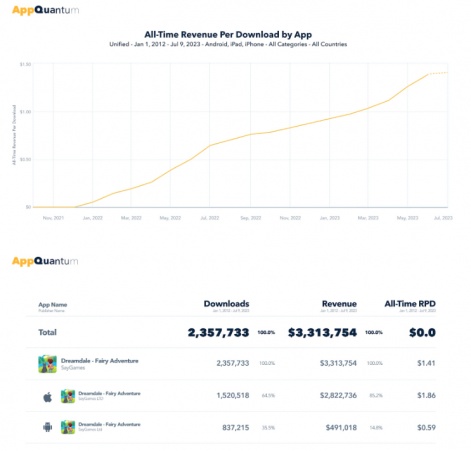
One of the reasons is the 1.0.23 update (Google Play – 09.03.23, App Store – 16.03.23), which significantly overhauled the equipment system, introduced a Battle Pass, and added monetization through glyphs inspired by the mobile ARPG Diablo Immortal (we’ll delve deeper into this shortly).
Dungeons in the Mid-Late game became more challenging, amplifying the need for equipment. However, players can’t directly purchase their desired equipment item. This is where the glyph mechanic comes into play. By acquiring them, users can enhance their chances of obtaining more various and valuable loot. Thus, with the release of this update, SayGames focused on the RPG system and introduced new In-App monetization growth points for Mid-Late content.
We assume such changes could have significantly affected the conversion rate of paying users and ARPPU.
All these changes were made shortly before the onset of a major UA-scaling campaign. There are several intriguing aspects to this, which we will explore in more detail.
Having analysed the ratio of downloads to revenue between the game versions, we concluded that SayGames put a particular emphasis on iOS, where the number of downloads in June reached 1,100,000. This considerably surpasses the figures from the month of the global launch, which were 741,000. The Android version also demonstrated significant download growth relative to April – 1,343,000, but couldn’t replicate the results of the global launch – 2,000,000. Additionally, our attention was drawn to the revenue distribution between the two versions in July 2023: $1,095,000 on iOS versus $204,000 on Android devices.
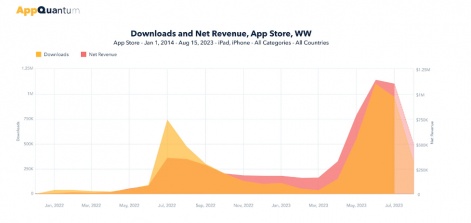

We have reason to believe that UA is the primary driver behind the revenue growth. Let’s closely examine the RPD and Revenue and Download curves to corroborate this. The RPD has been growing steadily without major spikes.
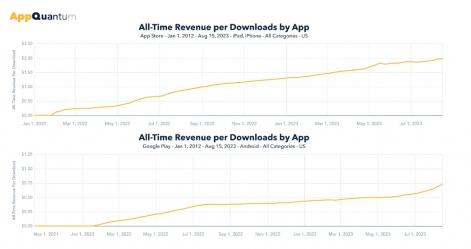
Since March 2023, revenue and download curves mirror each other on iOS and Android platforms.
We also analysed active UA campaigns and identified one creative showing a rapid ascent. This playable creative scales with AppLovin, which accounts for a massive portion of the spend among all Dreamdale campaigns.
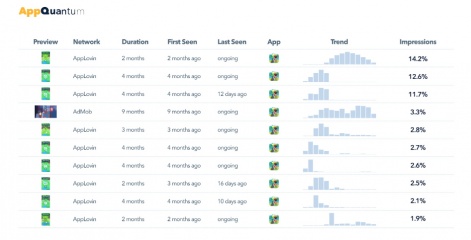
Looks like that particular Dreamdale’s creative was inspired by one of Gold & Goblins’ ads. It employs an altered gameplay approach: players will never encounter a similar situation in the actual game. Nevertheless, the clip effectively captures the game’s feel and, in essence, doesn’t deceive the player. Clicking on the link, users experience precisely the gameplay they anticipate, creating a sense of integrity and yielding good results.
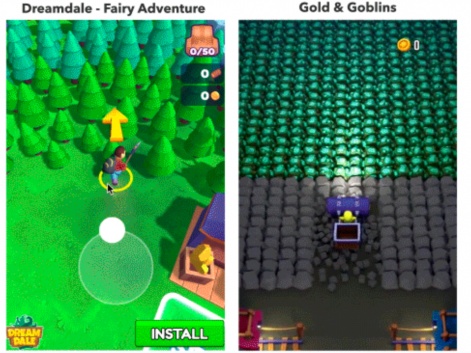
Dreamdale’s marketing campaigns also utilise networks such as AdColony, AdMob, BidMachine, Digital Turbine, inMobi, ironSource, Liftoff, Meta Audience Network, Mintegral, Tapjoy, Unity, Verve, Facebook, Instagram, TikTok, and YouTube.
Engaging Gameplay Experience
The game commences with motivation for the player: to save a captured princess and orchestrate the kingdom’s resurgence. This narrative unfolds through distinct, linear locations, each spotlighting key gameplay mechanics – from horseback explorations and combat systems echoing Archero to maritime adventures.
The introductory scene ends with the main character’s defeat in a battle against the sea monster. Marooned on an uninhabited island without any equipment, the player is imparted with crucial guidance and starts learning the game’s fundamentals.
Exploring the Game Mechanics of Dreamdale
Dreamdale boasts an array of mechanics that make the gameplay particularly captivating. Let’s analyse these elements to understand how the developers manage to captivate players and fuel their sense of adventure.
Movement Dynamics
The player is perpetually in motion, making the fluidity of movement a pivotal factor in retaining engagement. While the harmonious blend of smooth animations and pleasant walking sounds significantly enriches the gameplay experience, some might opine that the character’s pace is too slow. There’s a rationale behind this choice, which we will delve into later.
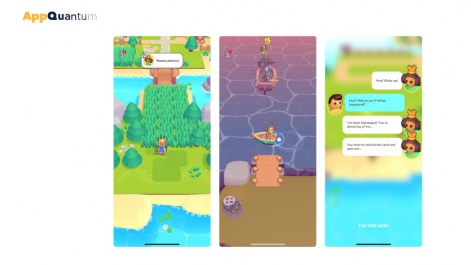
Quest System
The quests in Dreamdale stand out due to their concise and simple nature. They serve as catalysts, nudging players to traverse the island, gather resources, construct and upgrade new buildings, and venture into dungeons. Within a single gameplay session, players can accomplish from 5 to 30 quests.
Such diverse gameplay dynamics ensure monotony never settles in, often leading players to adopt the “just one more quest before calling it a night” mindset. Players are also consistently rewarded for their efforts, with incentives ranging from soft currency to fragments of relics.
The Art of Resource Collection
Second only to movement, the resource collection mechanism is integral to the game. Engaging in this activity often feels meditative: players simply guide their character to a chosen resource, and the rest unfolds autonomously. However, not all resources are collected at the same pace – some take longer, which can occasionally impede progress. This approach subtly pushes players towards attractive offers that promise a quicker resolution. As players advance, they can automate gathering most resources by unlocking facilities such as mines and sawmills. Yet, each of them comes with its own harvesting cap.
In Dreamdale, it’s not rare to get a sequence of quests necessitating a meticulous journey through intricate logistical chains. The game smartly positions different offers, allowing players to purchase large quantities of slowly produced resources. Consequently, In-Apps and Ad placements gain elevated significance from the players’ perspective.
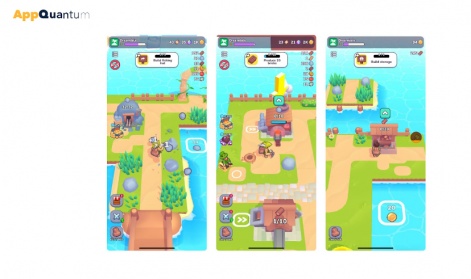
Expansion of Territories
In this game, unveiling new areas is a fundamental mechanic. Players must expand their territories by using accumulated resources to accomplish certain quests. However, exploration has its boundaries. At some juncture, players will need unfamiliar resources, halting further territorial growth. This acts as the restrictive mechanic.
Riding Mechanics
For those vexed by the character’s unhurried pace, riding provides relief. Mounting a steed doubles the character’s speed, greatly enhancing the quality of player’s life, especially given the emphasis on ceaseless map traversal.
However, you can get a temporary riding animal only through ad placements or buying a VIP offer. Once the riding privilege lapses, the stark contrast in navigation speed becomes obvious, pushing players to renew their purchase. Notably, the required placement is readily accessible in a dungeon’s initial chamber, greatly speeding up its sweep.
Fishing and Aquatic Commute
The tranquil activity of resource collection can become monotonous. Therefore, after a couple of hours into the game, players are introduced to fishing. Here, a designated zone emerges in front of the boat, wherein players must keep the fish within bounds until a progress bar completes. The fish’s size influences both the time needed to capture it and the amount of resources the user will receive. If fishing isn’t appealing, the boat doubles up as a swift alternative to terrestrial mounts.

Foundation Structures
Early in their journey, players gain access to two pivotal structures: the Town Hall and the Market. The Town Hall serves as a hub for enhancement, allowing players to augment their carrying capacity, enlarge their storage, upgrade tools like axes, pickaxes, and fishing rods, and optimise resource harvesting structures. Meanwhile, the market offers a straightforward proposition: trading gathered resources for gold. Everything is simple and easy to understand!
Development of Settlements
As players progress, they evolve their camp into a personalised settlement, with each structure playing a distinctive role:
- Museum. Unlocking statues for various buffs.
- Laboratory. Essential for purchasing blueprints to build new structures.
- Library. Amplifies gem mine productivity. To upgrade, scrolls are necessary. These can either be found in dungeons or purchased from the In-App store.
- Lighthouse. Provides maps facilitating travel to other islands via a sailing ship, essential to complete the main quest and rescue the princess.
- Player’s House. Offers a decorating feature and becomes available after completing the main quest.
- Furniture Store. Allows players to buy stuff for their homes.
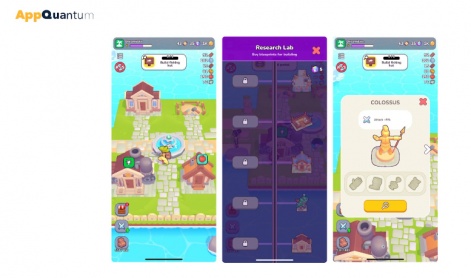
Interior Enhancements
After building the Furniture Store, players can buy and place furniture, elevating their house’s level (separately from their character progression). Inside the store, several slots display random items for purchase. Once purchased, a 60-minute countdown commences, which can be bypassed by viewing a Rewarded Video (RV).
Battle Dynamics
Dreamdale introduces its battle system through the concept of dungeons. At a certain point, players access a new building – the portal, which serves as their entry to the dungeon.
Here, they encounter two new mechanics: health points and hostile mobs, each with distinct attack patterns, which the visualised trajectory of the blow can predict. Eliminating foes rewards players with experience, used for boosting attack power, health, and equipment, and also with soft currency. Each level ends with a boss fight. Yet, the dungeons feature side rooms with chests and more foes, diversifying gameplay and fostering an explorative approach.
While Dreamdale’s dungeon mechanics may come off as traditional, as we said before, the game does incorporate elements from the renowned mobile ARPG Diablo Immortal – glyphs that augment resource extraction in portals, which can be bought in the In-App store, serving as an extra monetization point.
Players also find rainbow gems within these dungeons necessary for buildings’ blueprints. The game’s elements are tightly woven together, showcasing the intricate design behind Dreamdale.
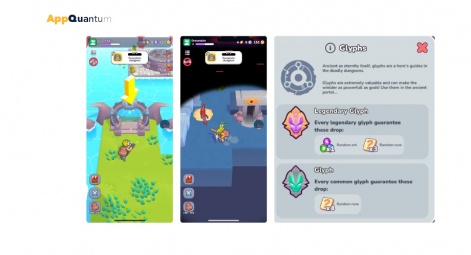
Managing Resource Shortages
Dreamdale employs strategic pacing to ensure players don’t advance too swiftly or lose interest. As users journey through the game, they encounter deliberately paced resource production challenges. While they can generate these resources independently, the process is labour-intensive and often requires standing next to production structures, creating a sense of grind. This “trap” is felt especially strongly when several types of these resources are required for further progression. However, at the right moment, a tempting in-game offer emerges to help players.
Monetization
Dreamdale’s diverse mechanics aren’t solely for gameplay enrichment and player retention. They also serve as pivotal monetization points, which we’ll delve into. It’s noteworthy to reiterate that Dreamdale has amassed over $5,900,000 exclusively from In-Apps.
Rewarded Videos
Serving as a primary monetization cornerstone, Rewarded Videos simplify various tasks. They predominantly appear at resource-gathering junctures, allowing players to save their time considerably.
Faced with the challenge of cultivating a specific amount of pumpkins? Need to establish a sawmill but lack the required apples that are quite distant? Backpack filled to capacity? These scenarios illustrate how the game crafts points of scarcity, presenting corresponding solutions. In such contexts, players often opt to view ads to conserve time. Profit!
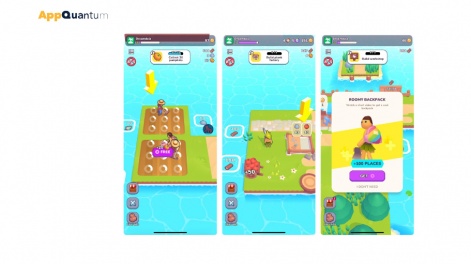
Interstitials
Instead of merely being vehicles for ads, Dreamdale’s interstitials aim to convert players into paying users via the No Ads purchase. This offer, bundling resources and tickets, amplifies its appeal. Additionally, acquiring substantial amounts of soft currency or tickets also grants No Ads. In the top purchases chart, Ad-free offer is ranked first place.
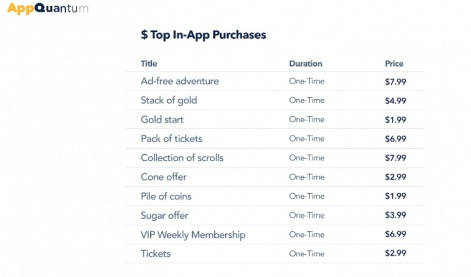
Tickets offer players the ability to bypass Rewarded Videos. Given the pronounced influence of RV on gameplay pace, tickets are purposefully scarce. Unlike No Ads, their amount is limited to maintain the balance and progression rate within the game.
Offers
A standout attribute of Dreamdale’s offers is their impeccable timing. The developers know players’ pain points well, crafting offers that enhance gameplay enjoyment at just the right moments.
- One-Time Offer. Typically extends a significant discount (e.g., 40% off a specific package). However, there’s a catch: once the offer window is closed, it is off the table.
- Coins Offer. Provides discounted currency packs, but they are valid only for 5 hours. The discount rate is typically less generous than the One-Time Offer.
- Special Offer. Introduced when players face their first large resource harvesting task and offers a Starter Pack with a small amount of resources. Contrary to other time-sensitive deals, players can access this offer any time by approaching the Leprechaun.
- VIP Offer. A subscription package featuring No Ads, a daily allotment of 5 tickets for bypassing Rewarded Videos, expanded backpack capacity, and unlimited access to riding animals. Subscription durations span 7, 30, or 365 days.
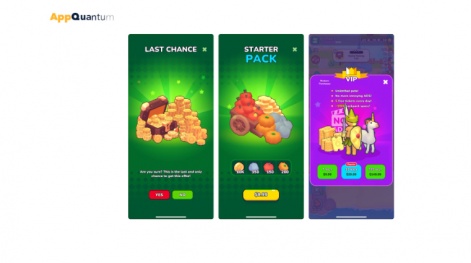
Battle Pass
A relatively new type of monetization for Dreamdale featuring three levels: free, mid-tier, and expensive. Each tier incorporates the rewards of its preceding level. The Battle Pass operates on time-defined seasons, offering tiered prizes. Players expend a unique currency acquired during raids to advance through these stages.
The Dreamdale Success Formula
- The development team leveraged the success of My Little Universe, using it as a foundation to craft a broader and more refined gaming experience.
- Dreamdale masterfully blends intuitive, beginner-friendly core gameplay with intricate progression underpinned by lots of micro-mechanics.
- The developers have done a lot of work with the resource harvesting design to make the offers as valuable and attractive as possible for the player.
- Certain game features, such as horseback riding, encourage habitual usage of placements. As players’ maps expand, traversing without a mount becomes cumbersome and time-consuming.
- The core appeal of Dreamdale’s offers and ad placements lies in their ability to save players’ time and minimise tedious grinding.
- Rather than serving as mere ad revenue generators, Dreamdale’s interstitials are geared towards nudging players towards making In-App purchases, especially the No Ads feature.
Edited by Paige Cook

